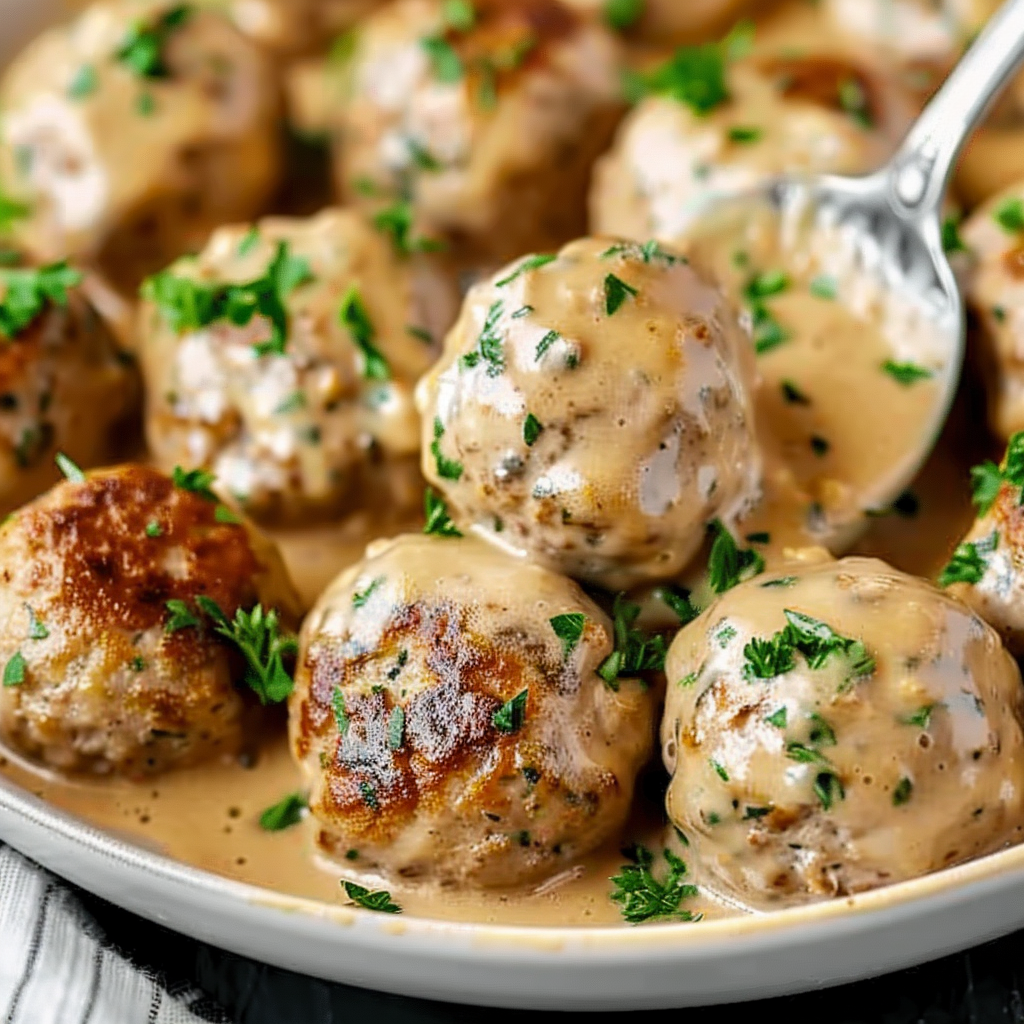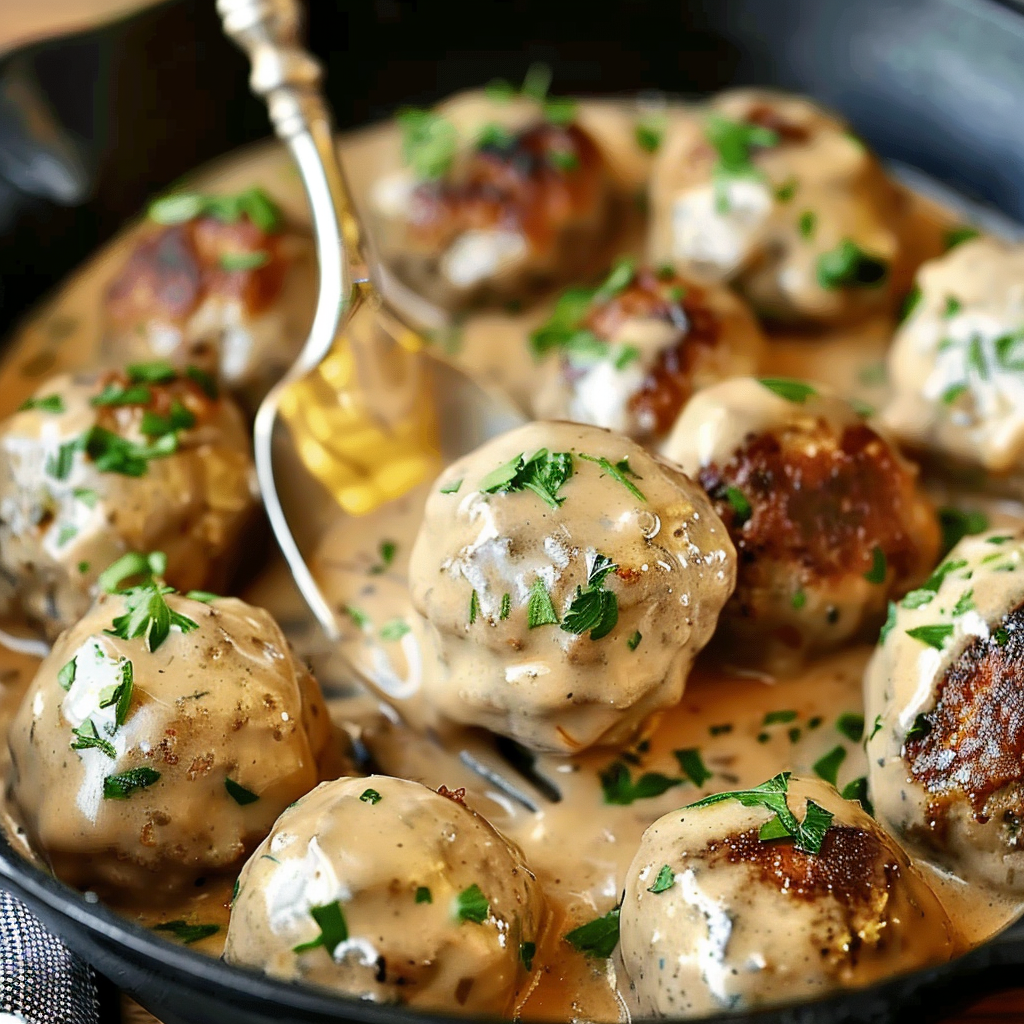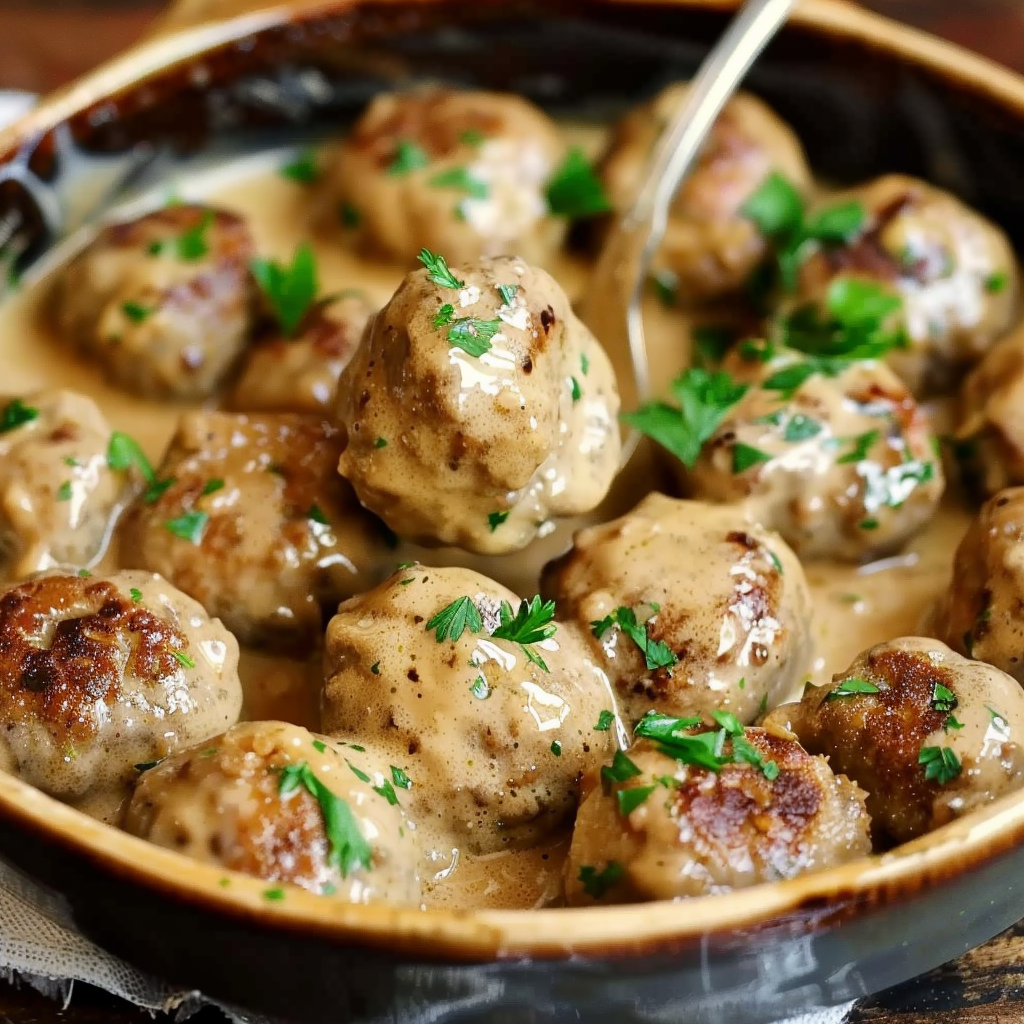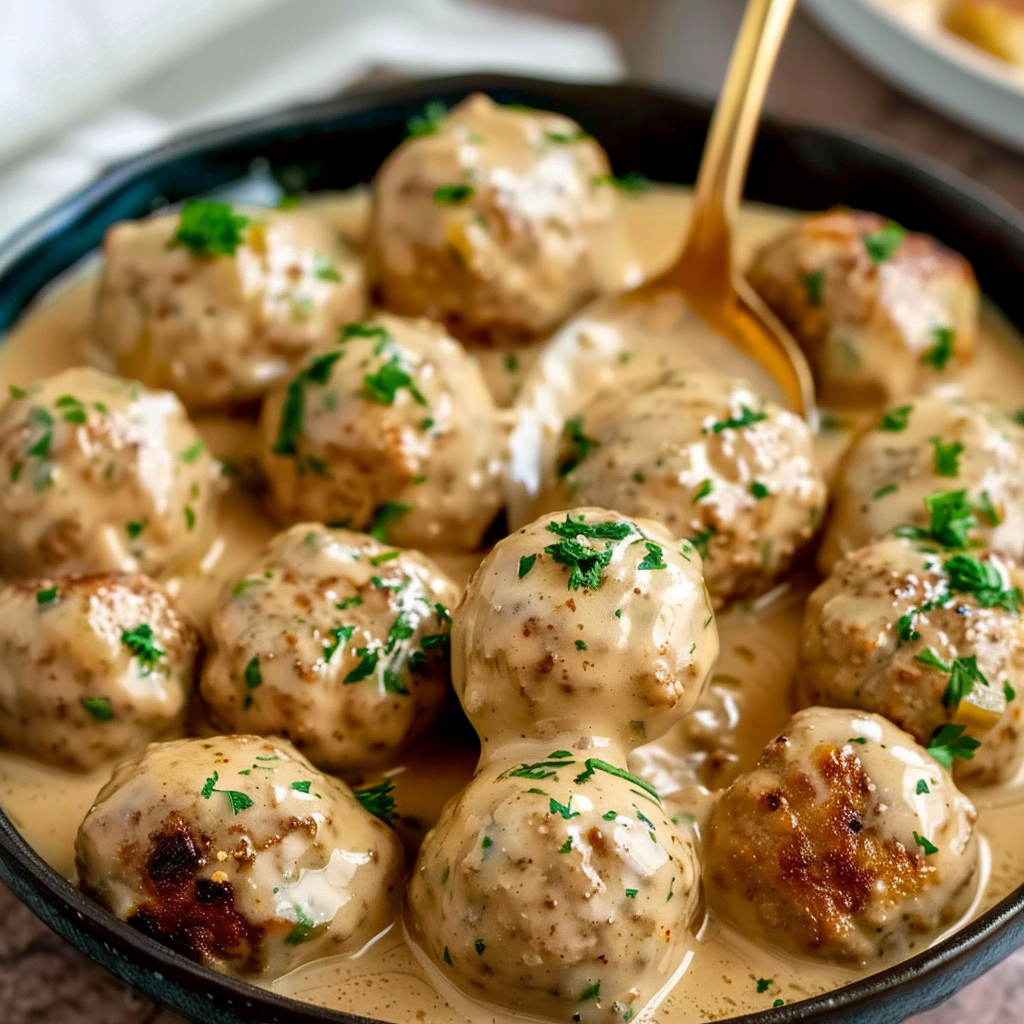1.Swedish Meatballs
Swedish meatballs, or köttbullar, are more than just a comforting dinner—they’re a cultural icon. Known for their tender texture, aromatic spice blend, and creamy brown gravy, these meatballs have earned a special place on dinner tables around the world. Whether you’re craving a cozy winter dish or recreating a beloved IKEA-style meal, making them at home delivers that same classic taste with fresher, more customizable ingredients.
Unlike the Italian counterpart, Swedish meatballs are smaller, more delicate in seasoning, and traditionally served with mashed potatoes and lingonberry jam. This pairing creates a harmony of savory, creamy, and slightly sweet notes that’s distinctively Nordic. The key to authenticity lies in both the spice mix—typically including allspice and nutmeg—and the gravy made with beef broth and heavy cream.
Rooted in Swedish cuisine, these meatballs have evolved over time but continue to reflect the resourceful and hearty nature of traditional Scandinavian cooking. Their popularity has also been amplified globally through brands like IKEA, where fans experience a simplified but beloved version. But you don’t need a cafeteria tray or trip abroad to enjoy them—this guide will walk you through making classic Swedish meatballs at home with simple ingredients and step-by-step instructions.
For a closer look at the history behind meatballs in general and how the Swedish variety fits into that lineage, you can explore this informative meatball overview. As you’ll see, every region has its own spin, but few match the balanced, homey flavors that define Sweden’s version.
Ready to master Swedish meatballs with creamy gravy and a dollop of sweet-tart jam? Let’s get started with the essential ingredients and flavor combinations that make this dish unforgettable.

2. What Makes Swedish Meatballs “Swedish”?
At first glance, Swedish meatballs may seem similar to other meatball varieties. But their distinct identity lies in the ingredients, preparation, and especially in the serving style. Unlike Italian meatballs, which are typically served with tomato sauce and pasta, Swedish meatballs are accompanied by a creamy gravy, buttery sides, and often, lingonberry jam—a combination that sets them apart as a uniquely Scandinavian comfort food.
The traditional spice profile includes allspice and nutmeg, which deliver warm, slightly sweet undertones. These spices are rarely found in other meatball recipes, making them a signature part of the dish. According to the allspice Wikipedia entry, this spice is often used in Northern European cooking and contributes to the earthy, aromatic depth that defines authentic Swedish meatballs.
Meat choice also plays a key role. Classic recipes use a blend of ground beef and pork, though substitutions like chicken or turkey are common for a lighter version. Unlike coarser Italian meatballs, the Swedish version is smoother and more delicate due to soaked breadcrumbs and milk, which keep the meat tender and juicy.
Beyond ingredients, presentation is a defining element. The dish is typically plated with mashed potatoes or buttered egg noodles, then topped with silky gravy and served alongside a spoonful of lingonberry jam. The tartness of the jam cuts through the richness of the sauce, offering a balanced contrast. This iconic pairing is deeply rooted in Swedish culinary tradition and frequently featured in Nordic comfort food boards on Pinterest for its visual and flavor appeal.
When prepared properly, the harmony between spice, creaminess, and sweetness is what elevates Swedish meatballs beyond a basic meat dish. This balance of flavors has made them a global favorite, while still holding tightly to their Scandinavian roots.
3. Ingredients for Classic Swedish Meatballs
Crafting authentic Swedish meatballs begins with selecting the right ingredients. The components are simple yet thoughtfully balanced to create the signature texture and flavor. Each ingredient plays a specific role in producing the rich, creamy, and subtly spiced profile that defines this beloved dish.
3.1 Meatball Base
-
Ground beef (1 lb): Offers hearty flavor and structure.
-
Ground chicken (½ lb): Used as a lean substitute for traditional pork, softens the overall texture.
-
Breadcrumbs (½ cup): Soaked in milk, they prevent the meatballs from becoming dense.
-
Milk (¼ cup): Helps tenderize the meat and keeps the interior moist.
-
Egg (1): Binds the mixture together.
-
Onion (1 small, finely chopped): Adds moisture and savory depth.
-
Salt and black pepper: Fundamental seasonings for balance.
This mixture is designed to be soft, but not too loose. Allowing the breadcrumbs to absorb the milk fully before mixing is essential for optimal texture. For visual inspiration, explore Swedish meatball dinner plate ideas to see how these components come together on the plate.
3.2 Swedish Spices
-
Ground allspice (¼ tsp): Adds warm, peppery sweetness.
-
Ground nutmeg (¼ tsp): Brings a subtle nutty aroma, enhancing depth.
-
Optional spices: A pinch of white pepper or garlic powder for personal taste.
These warm spices are what truly make the dish “Swedish.” For more detail on this unique seasoning, visit the allspice page to understand its historical use in Northern European cooking.
3.3 Creamy Brown Gravy
The signature Swedish gravy is luxurious and smooth, made using:
-
Butter (4 tbsp): Creates the roux base.
-
All-purpose flour (¼ cup): Thickens the gravy.
-
Beef broth (2 cups): Adds rich, meaty flavor.
-
Heavy cream (¾ cup): Offers velvety texture.
-
Worcestershire sauce (1 tbsp): Adds umami depth and color.
A well-made gravy elevates the dish and coats each meatball in silky, flavorful sauce. To understand the background and versatility of this ingredient, read more on Worcestershire sauce.
3.4 Optional But Traditional Accompaniments
-
Mashed potatoes: Creamy and buttery, they absorb the gravy well.
-
Buttered noodles or white rice: Alternative starches with a neutral base.
-
Lingonberry jam: Tart and sweet, traditionally served on the side. If you’re interested in making your own, check out DIY lingonberry jam on Pinterest for quick recipes.
These accompaniments don’t just fill the plate—they complete the flavor experience. You can explore more pairing options and serving visuals through mashed potato pairings for ideas that complement the dish’s creamy, savory profile.
This foundational ingredient list ensures you’re well-equipped to create a dish that balances hearty, spiced meatballs with a rich, comforting gravy and traditional Nordic sides.
4. Step-by-Step Recipe: How to Make Swedish Meatballs at Home
4.1 Mixing the Meatball Ingredients
Begin by soaking breadcrumbs in milk for a few minutes in a large mixing bowl. This critical step ensures the meatballs stay moist and tender. Once the breadcrumbs have absorbed the liquid, add the ground meats—beef and chicken—along with the finely chopped onion, egg, salt, pepper, allspice, and nutmeg. Use clean hands or a wooden spoon to gently combine everything. Be careful not to overmix; doing so can result in tough meatballs.
The inclusion of soaked breadcrumbs, called a panade, is a traditional method in Swedish cuisine to produce a soft, melt-in-your-mouth bite. If you’d like to see how this texture appears once cooked, Pinterest has an array of meatball gravy recipes showcasing final presentations and cuts.
4.2 Shaping the Meatballs
Once the mixture is uniform, begin shaping the meat into small balls about 1 inch in diameter. Aim for consistent sizing to ensure even cooking. Wetting your hands slightly with cold water can help prevent sticking. You should get approximately 24–30 meatballs from the batch, depending on size.
At this stage, many home cooks wonder how to achieve the perfect texture and look. For that, take a peek at curated Swedish meatball plating ideas that highlight both rustic and refined versions of the dish.
4.3 Frying the Meatballs
Heat butter in a large skillet over medium heat. Avoid using oil alone—butter not only aligns with traditional preparation but also adds rich flavor to the exterior. Fry the meatballs in batches to prevent overcrowding. Brown them on all sides until fully cooked through, turning gently with tongs. This step develops both flavor and texture by creating a golden crust.
Once cooked, transfer the meatballs to a paper towel-lined plate and set them aside while you prepare the gravy. The browned bits left behind in the pan (fond) will add extra depth to the sauce, a technique often used in both Nordic and French comfort food.
4.4 Making the Gravy
In the same skillet, melt butter and whisk in flour to form a roux. Stir constantly for 1–2 minutes until it takes on a light golden color. Gradually whisk in beef broth, ensuring there are no lumps, followed by heavy cream and Worcestershire sauce. Simmer gently for 5–7 minutes, allowing the gravy to thicken.
This creamy sauce is what sets Swedish meatballs apart from most other global variations. As detailed in the Worcestershire sauce entry, this ingredient provides umami and balances the cream with a slightly tangy note. For more visual examples, you can explore meatball gravy inspiration that demonstrates how the sauce should look when finished.
4.5 Combining and Simmering
Once the gravy has thickened to your liking, return the meatballs to the skillet. Spoon the sauce over them, and let them simmer gently for 5 more minutes. This final step helps meld the flavors and warms the meatballs all the way through.
Serve them hot, spooned over mashed potatoes, buttered noodles, or even steamed rice. Don’t forget the essential spoonful of lingonberry jam on the side for a true Swedish flavor experience. You’ll find that the sweet-tart contrast creates a layered, memorable bite—an ideal representation of Nordic comfort food.
This step-by-step process gives you full control over flavor, texture, and authenticity—turning a beloved dish into a homemade favorite with ease.

5. Serving Suggestions
Serving Swedish meatballs properly is just as important as cooking them well. The traditional accompaniments enhance the dish’s savory and creamy qualities, while adding visual and textural contrast. Whether you’re keeping it classic or exploring modern pairings, each element on the plate should complement the rich, spiced meatballs and velvety gravy.
5.1 Traditional Swedish Pairings
The most authentic way to serve Swedish meatballs is with:
-
Mashed potatoes: Soft and buttery, they absorb the gravy perfectly and add comfort to every bite. For pairing inspiration, check out these mashed potato pairings to see how others are plating this classic combination.
-
Lingonberry jam: A Scandinavian staple, its tart sweetness balances the richness of the meatballs and sauce. Learn more about this traditional berry at the lingonberry Wikipedia page. If you want to try making it yourself, there are plenty of recipes for DIY lingonberry jam that show how to preserve its bright, berry flavor.
These pairings aren’t just nostalgic—they’re rooted in centuries of Swedish cuisine. The sweet and savory balance is a hallmark of Nordic comfort food, where rich proteins are often paired with acidic or fruity components for harmony.
5.2 Modern or Low-Carb Pairings
For those looking to modernize or lighten the dish:
-
Cauliflower mash: A low-carb alternative that still offers creaminess and texture.
-
Zoodles (zucchini noodles): A gluten-free, lighter pairing that adds freshness.
-
Steamed white or brown rice: Especially good if you want a neutral base that won’t compete with the flavors.
-
Buttered egg noodles: Commonly used in American-Swedish adaptations, they’re simple and satisfying.
Visual inspiration for alternative plating can be found through Swedish meatball plating ideas that feature creative sides, garnishes, and serving styles.
Whether sticking to tradition or adapting for dietary needs, the goal is to create a balanced plate where every bite is warm, flavorful, and satisfying.
6. Storage, Reheating, and Freezing Tips
Knowing how to properly store and reheat Swedish meatballs ensures they remain just as delicious the next day—or even weeks later if frozen. Their rich gravy and tender texture make them ideal for preparing in advance.
-
Refrigeration: Store cooled meatballs and gravy together in an airtight container in the refrigerator for up to 4 days. Keeping the sauce with the meatballs helps preserve moisture and flavor.
-
Reheating: Reheat gently in a skillet over low to medium heat, adding a splash of beef broth or cream if the gravy has thickened too much. Avoid microwaving, as it can cause the meatballs to dry out or the sauce to separate.
-
Freezing (Cooked): Let meatballs and gravy cool completely, then transfer to a freezer-safe container. Freeze for up to 3 months. Defrost in the fridge overnight before reheating.
-
Freezing (Uncooked): You can also freeze uncooked meatballs on a parchment-lined tray. Once frozen solid, transfer to a sealed bag. Thaw before cooking, or cook directly from frozen, adding extra cooking time.
These steps make Swedish meatballs a convenient make-ahead meal that doesn’t compromise on taste or texture.
7. Variations & Substitutions
Whether you have dietary restrictions or just want to try a new twist, Swedish meatballs are versatile and easily adaptable. These substitutions maintain the dish’s comforting character while offering new flavor profiles.
7.1 Meat Options
-
Ground turkey: A lean substitute for both beef and pork, with a milder flavor.
-
All-beef version: Intensifies the savory taste and is easier to find in most kitchens.
-
Vegetarian option: Use lentils or plant-based ground “meat” alternatives and bind with breadcrumbs and egg or a vegan substitute.
7.2 Dairy-Free or Gluten-Free Adaptations
-
Dairy-free: Replace milk and cream with unsweetened almond milk, coconut milk, or a soy-based cream. Use dairy-free butter alternatives for frying and gravy.
-
Gluten-free: Use gluten-free breadcrumbs and substitute gluten-free flour for the roux. Always double-check the Worcestershire sauce label, as some brands may contain gluten.
7.3 Flavor Twists
-
Add a teaspoon of Dijon mustard to the gravy for subtle tang.
-
Mix in fresh parsley or dill for a Scandinavian herb lift.
-
For a richer taste, fold in a bit of Parmesan cheese to the meat mixture (not traditional, but flavorful).
Pinterest boards featuring Nordic comfort food often showcase creative adaptations, helping you tailor the recipe to your preferences.
8. Tips from Swedish Home Cooks
For truly authentic Swedish meatballs, these insights from home cooks in Sweden make a big difference:
-
Use stale white bread soaked in milk rather than dry breadcrumbs for softer meatballs.
-
Fry in batches to ensure even browning and avoid steaming the meatballs.
-
Let the mixture rest before shaping to help flavors meld and make forming easier.
-
Use cold hands when shaping to prevent the fat from melting prematurely.
These practical details elevate your results from good to great and reflect the subtle techniques passed down through generations.
9. Common Mistakes to Avoid
Avoid these common errors to ensure your Swedish meatballs come out perfect every time:
-
Overmixing the meat: This makes the meatballs tough and dry. Mix just until combined.
-
Lumpy gravy: Always whisk slowly when adding liquids to your roux to maintain a smooth texture.
-
Undercooking or overcrowding: Cook in batches and ensure meatballs reach a safe internal temperature without burning the exterior.
-
Skipping the jam: While optional, the lingonberry jam is key to the authentic flavor balance. Replace it with cranberry sauce only if needed.

10. FAQ – Based on “People Also Ask”
What is the difference between Swedish meatballs and regular meatballs?
Swedish meatballs are smaller, use warm spices like allspice and nutmeg, and are served with cream gravy instead of tomato sauce. They’re traditionally accompanied by mashed potatoes and lingonberry jam, unlike Italian or American versions.
What is Swedish meatball sauce made of?
The sauce is a creamy gravy made from a roux (butter and flour), beef broth, heavy cream, and Worcestershire sauce. Some variations include mustard or soy sauce for extra depth.
Why are Swedish meatballs served with jam?
Lingonberry jam provides a tart, fruity contrast to the rich gravy and meat. This sweet-savory balance is a signature of Nordic comfort food and essential to the dish’s traditional flavor.
Can I bake Swedish meatballs instead of frying them?
Yes. You can bake them at 400°F (200°C) for about 18–20 minutes. However, frying gives a better texture and flavor, especially when using butter.
How do you keep Swedish meatballs from falling apart?
Make sure to use a binding agent like egg and breadcrumbs soaked in milk. Also, chill the meat mixture briefly before shaping and avoid flipping them too early while frying.
Are Swedish meatballs better with noodles or mashed potatoes?
Traditionally, they’re served with mashed potatoes, but buttered noodles are a popular alternative. Both absorb the gravy well, so it’s a matter of preference.
Can I make Swedish meatballs ahead of time?
Yes. They’re ideal for meal prep. Store cooked meatballs and gravy in the fridge or freezer and reheat gently. You can also freeze raw meatballs and cook them later.
What can I use instead of lingonberry jam?
If lingonberry jam isn’t available, try using cranberry sauce (unsweetened or low-sugar), red currant jelly, or even tart cherry preserves. They won’t taste exactly the same, but they offer a similar sweet-tart balance.

How To Make Classic Swedish Meatballs At Home
- Author: Naomi
Description
Swedish Meatballs with Gravy is a classic Scandinavian dish featuring tender meatballs seasoned with allspice and nutmeg, simmered in a rich, creamy beef gravy, and traditionally served with mashed potatoes and lingonberry jam. This homemade version offers authentic flavor and comforting texture, perfect for a cozy family dinner or entertaining guests with a taste of Nordic cuisine. Balanced between savory and sweet, this dish delivers tradition in every bite.
Ingredients
For the meatballs:
- 1 pound ground beef
- 1/2 pound ground chicken (in place of pork)
- 1 small onion, finely chopped
- 1/2 cup breadcrumbs
- 1/4 cup milk
- 1 egg
- 1/2 teaspoon salt
- 1/4 teaspoon black pepper
- 1/4 teaspoon ground allspice
- 1/4 teaspoon ground nutmeg
- 2 tablespoons butter, for frying
For the gravy:
- 4 tablespoons butter
- 1/4 cup all-purpose flour
- 2 cups beef broth
- 3/4 cup heavy cream
- 1 tablespoon Worcestershire sauce
- Salt and black pepper, to taste
Instructions
- In a bowl, combine breadcrumbs and milk. Let sit for a few minutes until absorbed.
- Add ground beef, ground chicken, onion, egg, salt, pepper, allspice, and nutmeg. Mix until just combined.
- Shape the mixture into small balls, about 1 inch in diameter.
- In a large skillet, melt butter over medium heat. Add the meatballs in batches and cook until browned on all sides and cooked through. Remove and set aside.
- In the same skillet, melt butter for the gravy. Whisk in the flour and cook for 1–2 minutes to form a roux.
- Slowly add the beef broth, whisking constantly to avoid lumps. Stir in heavy cream and Worcestershire sauce.
- Simmer the gravy until thickened, about 5–7 minutes. Season with salt and pepper to taste.
- Return the meatballs to the skillet and coat with the sauce. Simmer for a few minutes until heated through.
- Serve warm, traditionally with mashed potatoes or egg noodles.
Notes
-
Meat Blend Tip: Use equal parts beef and pork (or chicken) for the most authentic texture.
-
Spice Level: Stick to the classic spice mix for tradition, or add white pepper for a bolder profile.
-
Lingonberry Substitute: If unavailable, opt for unsweetened cranberry sauce or red currant jelly.
-
Make Ahead: Both meatballs and gravy freeze well, making this a great meal prep option.
-
Serving Suggestion: For a festive touch, garnish with fresh parsley and serve on a Scandinavian-style platter.









